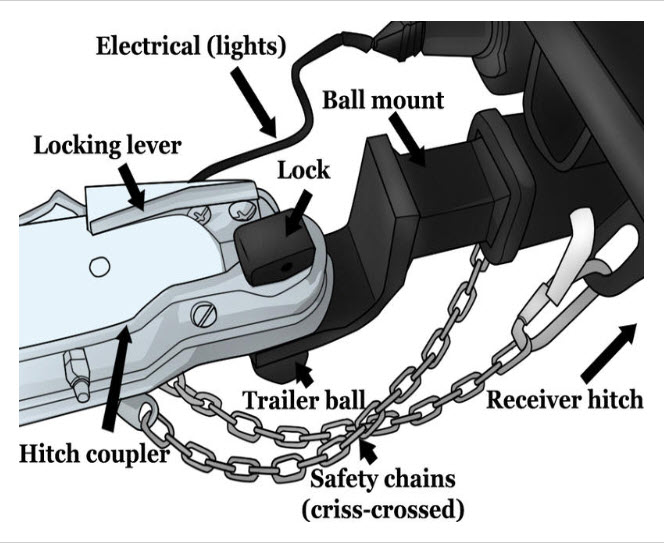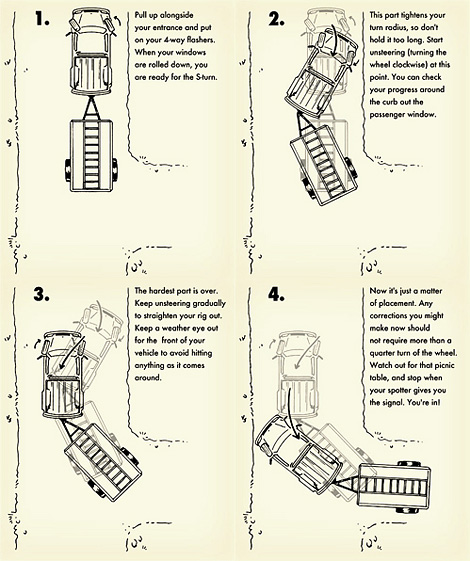Tips For Towing A Trailer
Whether you’ve just bought your first truck and you’re dying to test out the towing capabilities or you’re ready to buy that jet ski or new boat you’ve had your eye on, if you plan to use your vehicle to tow a trailer, there are many important things to consider before you hitch up the trailer and hit the road. From the type of hitch to the weight you are hauling, you need to be knowledgeable about various aspects of towing, including the capabilities of your vehicle and the unique complications of towing a trailer. Your safety — and the safety of those around you — depends upon it.
Capabilities Of Your Tow Vehicle
First and foremost are the towing capabilities of your vehicle. For the most part, modern cars and even larger sedans are not equipped for towing — and even some SUVs have serious limitations on weight and functionality for towing trailers. The good news is there are a lot of vehicles that come ready to tow, including Honda Odyssey, Honda Pilot and Honda Ridgeline (when properly equipped with a tow package option.) Read your owner’s manual to learn what the specifications for your vehicle are and what needs to be considered when towing with your specific vehicle.
Type of Hitches
Hitches consist of a variety of components that connect to join your vehicle to the trailer. Working as one, the hitch components include the following:
- Receiver: The receiver is the square tube on your vehicle that connects everything else to your vehicle. Receivers come in five classes based on the gross trailer weight that will be pulled:
- Class I: Maximum Gross Trailer Weight (GTW) up to 2,000 pounds
- Class II: Maximum GTW up to 3,500 pounds
- Class III: Typically up to 8,000 pounds GTW, but some are less depending on how they are mounted to the vehicle
- Class IV: Up to 10,000 pounds GTW
- Class V: Up to 20,000 pounds GTW
- Ball Mount and Trailer Ball: A ball mount is a square tube that slides into the receiver, is secured to the receiver with a hitch pin and mounts the trailer ball. Note that receivers and ball mounts come in multiple tube sizes (usually 1-1/2” inches square, 2” square and 2-1/4 inches square.) Be sure your ball mount matches the size of your receiver.
- Coupler: The coupler is the part on the front of the trailer that slides over and clamps to the trailer ball, connecting the trailer to your vehicle. Typically trailer balls and couplers are found in sizes of 1-7/8 inches, 2 inches and 2-1/4 inches. NOTE: The size of the coupler must match the size of the trailer ball. Even the small 1/8” difference between a 1-7/8” ball and a 2” coupler will cause the trailer to connect improperly — if it connects at all — and could cause a disastrous trailer disconnection even over the tiniest of bumps.

(Image Source: Transwest.com)
Every component in the hitch assembly has a rating like those of the receiver classes above. No component in the system can increase the tow capacity of your vehicle, and the least rated component determines the maximum load you can tow. For example, a ball mount rated at 8,000 pounds can still only tow 2,000 pounds if it is mounted in a Class 1 receiver.
Safety chains are also an important component of hitching up your trailer. Safety chains keep your trailer connected to your vehicle to maintain some control of the trailer if it becomes disconnected. Be sure to cross the chains under the hitch to act as a cradle if the trailer becomes uncoupled. The chains should be tight enough to hold the coupler off the ground (if it disconnects) while still being loose enough to allow the trailer to turn. Safety chains should never drag on the ground. If they are too long, wrap the excess around the trailer tongue securely.
Wiring for lights is the other critical component of hooking a trailer up to your vehicle. At a minimum, rear lights, brake lights and turn signals are required. If your vehicle has a trailer wiring connector, make sure the connector on the trailer matches or you will need to purchase an adapter.
Weight and Loading
By now you’ve noticed that weight is the major limiting factor in what and how you tow. Weight also impacts how your vehicle handles when towing and how your trailer handles when being towed. If your trailer is not properly loaded, it can lead to difficult towing, excessive swaying or other problems. When you are loading your trailer, ideally about 60% of the weight should be on the front of the trailer and 40% on the rear, with most weight over the axles.
For example, if too much weight is in the front of the trailer, it increases the tongue weight, which causes poor response by your towing vehicle. It can also cause other problems like lifting your headlights in the air and can cause excessive wear on the rear suspension components. This can be fixed by moving some of the load more towards the rear of the trailer.
If there is too much weight in the rear, it will cause the trailer to sway. Not only is trailer sway annoying when driving, it is downright dangerous. Fortunately it is usually resolved by moving more weight forward of the axle.
Driving and Maneuvering: Backing Up
Driving your vehicle with a trailer is very different than driving without one. Trailers add additional bumps and jolts to your ride, and your vehicle will not accelerate as quickly or stop as quickly. However, when your rig is properly configured and loaded, towing can be a pleasure and should not add to driver fatigue or stress.
Be aware that your rig will need more room to turn and maneuverability can be restricted. In some cases you’ve nearly doubled the length of your vehicle, so you need to remember to compensate for that. Glance at the trailer’s location in your mirrors as you round corners to make sure the trailer is going where you want it to. In some cases, your rearward vision may be completely blocked (especially in your windshield mirror.) Extended towing mirrors are available for added visibility.
Going forward is the easy part, backing up a trailer can be tricky. To start turning the trailer when backing up, you need to turn your vehicle the opposite direction, then once the trailer is headed the direction you want, you straighten the vehicle and essentially push the trailer to where you want it. This is easier if you place your hand on the lower part of the steering wheel, that way you are turning the wheel the same direction you want the trailer to go. If you can see, look over your shoulder to watch your trailer when backing up, but otherwise use your mirrors.
Use big turns to get started but go slow and don’t be afraid to stop, straighten it out and start over. Be aware of your surroundings so you don’t hit something with your vehicle while you are focusing on your trailer, and be very careful not turn so sharply that you jackknife your trailer. Using a spotter helps, but make sure they are standing somewhere that you can see them in your mirrors and that they are NEVER in the path of the vehicle or trailer.

(Image Source: Curt Mfg)
If you’ve never towed a trailer before, start slowly. Be careful and go slow until you gain enough confidence to drive normally. Don’t hesitate to practice, take your rig out to a large open area or empty parking lot and practice turning and backing up your rig. Hopefully you have a friend that can go out with you and coach you or even let you practice with his rig. Experience builds confidence. Towing can be like learning to drive all over again, but it really doesn’t take long to master. Tow safely!
If you’re looking for a Honda that will help tow your stuff, we can help! Neil Huffman Honda of Frankfort has Honda vehicles that can pull your trailer. Visit our showroom today.




